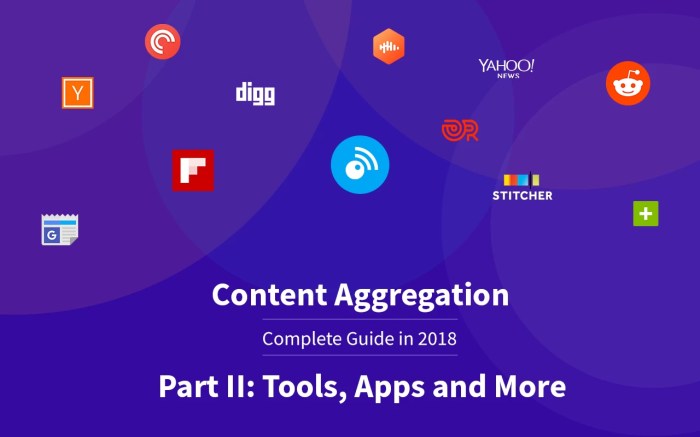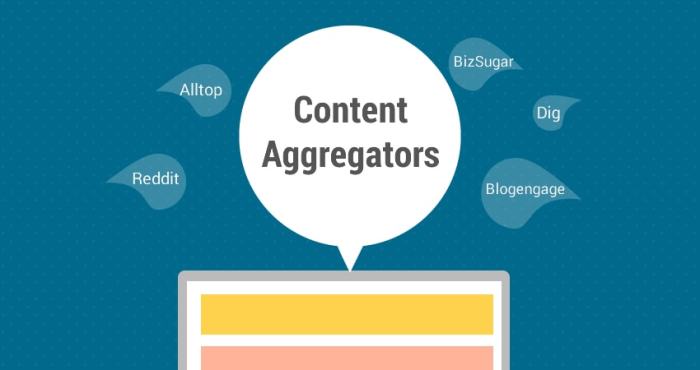Kicking off with Using Content Aggregation Tools, this guide is here to help you navigate the world of content curation like a boss. From saving time to enhancing quality, we’ve got you covered.
Whether you’re a business looking to level up your content game or a content creator aiming for efficiency, these tools are the game-changer you’ve been waiting for.
Benefits of Using Content Aggregation Tools

Content aggregation tools offer numerous advantages for businesses looking to streamline their content curation processes and enhance the quality and relevance of their content. These tools can save time and resources while ensuring that businesses stay up-to-date with the latest trends and news in their industry.
Streamlined Content Curation
- Content aggregation tools gather information from various sources, allowing businesses to access a wide range of content without the need to manually search for it.
- By automating the process of content collection, businesses can save valuable time and focus on analyzing and creating valuable insights from the curated content.
- These tools can help businesses stay organized by centralizing content from different sources in one place, making it easier to manage and share with team members.
Improved Content Quality and Relevance
- Content aggregation tools help businesses discover relevant content that aligns with their target audience’s interests and preferences.
- By aggregating content from reputable sources, businesses can ensure the credibility and accuracy of the information they share with their audience.
- These tools also enable businesses to monitor trends and topics in real-time, allowing them to create timely and relevant content that resonates with their audience.
Types of Content Aggregation Tools: Using Content Aggregation Tools
Content aggregation tools come in various forms to help users gather and organize information from multiple sources. Let’s explore the different types available in the market.
Automated Content Aggregation Tools
Automated content aggregation tools use algorithms to collect and display content from various websites based on specific s or topics. These tools require minimal manual input and are efficient at gathering a large volume of information quickly.
- Feedly: This tool allows users to aggregate content from their favorite websites and blogs into one easy-to-read feed.
- Google Alerts: Users can set up alerts for specific s and receive notifications when new content matching those s is published online.
Manual Content Aggregation Tools
Manual content aggregation tools rely on human curation to select, organize, and present content from different sources. Users have more control over the content selection process with these tools, but they require more time and effort to use effectively.
- Pocket: Users can manually save articles, videos, and other content to read later, organizing them into customizable collections.
- Flipboard: This platform allows users to create personalized magazines by curating articles, images, and videos from various sources.
Social Media Aggregation Tools vs. Content Curation Platforms
Social media aggregation tools focus on gathering content specifically from social media platforms like Twitter, Facebook, and Instagram. These tools help users monitor social media conversations and trends in one centralized location. On the other hand, content curation platforms like Curata and Scoop.it focus on collecting, organizing, and sharing content from a wide range of sources beyond social media.
- Social Media Aggregation Tools: Hootsuite, TweetDeck
- Content Curation Platforms: Curata, Scoop.it
Best Practices for Using Content Aggregation Tools
When it comes to utilizing content aggregation tools effectively, there are several best practices to keep in mind. These practices can help ensure that the content you aggregate is organized, credible, and regularly updated, maximizing the benefits of these tools. Let’s dive into some key considerations and strategies for making the most out of content aggregation tools.
Key Considerations for Selecting a Content Aggregation Tool
- Consider the specific purpose of the content aggregation tool you need.
- Look for tools that support the types of content sources you want to aggregate.
- Ensure the tool provides customization options to tailor the aggregation process to your needs.
- Check for user-friendly interfaces and reliable customer support for any troubleshooting needs.
Organizing and Categorizing Aggregated Content Effectively
- Create clear categories or tags to classify different types of content.
- Use filters and search functions to quickly access specific content within your aggregation tool.
- Regularly review and update your organization system to accommodate new content sources or changes.
- Consider creating curated collections or playlists for specific themes or topics.
Maintaining Credibility and Authenticity of Aggregated Content
- Always attribute the original sources of aggregated content to give proper credit.
- Avoid altering or misrepresenting the context of the original content when aggregating.
- Fact-check and verify the accuracy of information before including it in your aggregated content.
- Include diverse sources to provide a well-rounded perspective on the topics you cover.
Importance of Monitoring and Updating Content Aggregation Tools Regularly
- Set up alerts or notifications for new content additions or changes in your aggregated sources.
- Regularly review and remove outdated or irrelevant content to maintain the quality of your aggregation.
- Stay informed about any updates or improvements in the content aggregation tool you use.
- Engage with your audience to gather feedback on the usefulness and relevance of your aggregated content.
Legal and Ethical Considerations in Content Aggregation

When it comes to content aggregation, there are important legal and ethical considerations that need to be taken into account to ensure that you are respecting the rights of content creators and avoiding any copyright infringement.
Copyright Issues in Aggregating Third-Party Content
- Content aggregation involves collecting and republishing content from various sources, which can raise copyright concerns.
- It is crucial to understand that you cannot simply use any content you find online without permission, as it may be protected by copyright laws.
- Make sure to only aggregate content that you have the right to use or that falls under fair use exceptions.
Importance of Obtaining Proper Permissions and Attributions
- Before aggregating content, it is essential to obtain proper permissions from the original creators or copyright holders.
- Always give proper attribution to the sources you are using, acknowledging the original creators and providing links back to the original content.
- Obtaining permissions and attributions not only shows respect for the creators but also helps you avoid legal issues related to copyright infringement.
Avoiding Plagiarism and Copyright Infringement, Using Content Aggregation Tools
- To avoid plagiarism and copyright infringement, make sure to only use content that you have the right to use or that is in the public domain.
- Avoid copying content verbatim and instead focus on summarizing, quoting, or adding value to the information you are aggregating.
- Using proper citations and attributions can help you avoid accusations of plagiarism and ensure that you are following ethical practices.
Insights on Ethical Practices in Curating and Sharing Aggregated Content
- When curating and sharing aggregated content, always prioritize transparency and honesty with your audience.
- Provide context and add your own insights or commentary to the aggregated content to provide value to your audience.
- Avoid misleading or deceiving your audience by misrepresenting the original sources or taking credit for content that is not your own.